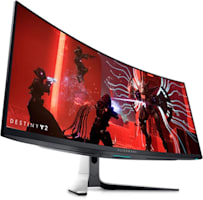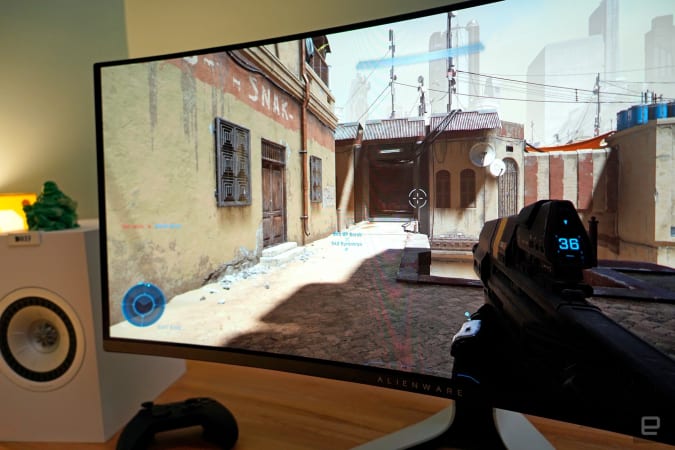Imagine everything you’d want in a gaming monitor — a bright and beautiful screen, a fast refresh rate for silky smooth graphics, HDR to really make things shine — and there’s a good chance you’ll find it in Alienware’s 34 Curved QD-OLED monitor. It’s one of the first screens to ship with Samsung’s Quantum Dot OLED panels, and it’s stacked with other features that’ll make your Halo Infinite matches all the more satisfying. While it may seem a bit extravagant at $1,299 compared to Apple’s $1,599 Studio Display it’s practically a steal. (Or maybe I’m just telling myself that to justify buying this thing.)
Gallery: Alienware 34 Curved QD-OLED gaming monitor | 15 photos
Gallery: Alienware 34 Curved QD-OLED gaming monitor | 15 photos
I’ll admit this up front: I’m a sucker for ultrawide (21:9) monitors. Having a tone of horizontal space makes it easy to juggle multiple apps at once, and it’s far cleaner than setting up multiple displays. So when Alienware revealed that it was finally debuting an OLED ultrawide, I was sold. While OLED has solidified its place in premium TVs, it’s taken a while to reach computer monitors (we only started getting OLED laptops regularly a few years ago). What makes this monitor even more intriguing is that it has all of the benefits you’d expect from OLED — deep black levels, excellent contrast and no backlight bleeding thanks to pixels that light up individually — but the addition of quantum dots means you’ll continue to see vibrant colors as the screen gets brighter.
pros
- Gorgeous and bright QD OLED screen
- Solid HDR peak brightness
- Fast response times
- Plenty of ports
Sure, this new tech means there’s another annoying display acronym to remember, but at least QD-OLED will offer some other notable upgrades. According to Samsung, it’ll be able to reach up to 1,000 nits of peak brightness (like this Alienware monitor), whereas the cream of the current OLED crop reaches around 400 nits. More brightness isn’t everything, especially since OLED’s perfect black levels can produce some eye-blistering contrast, yet it’s still a meaningful step forward as LCDs are becoming even more luminous with Mini-LED backlighting.
The Alienware QD-OLED monitor, like many 34-inch ultrawide models, features a 3,440 by 1,440 resolution. Think of it as an extra-long quad-HD screen: It’s not as sharp as 4K, but it’s still a huge leap ahead of 1080p. And since it doesn’t have as many pixels as a 4K screen, you’ll be able to play many games at its native resolution without taking out a loan for an RTX 3080 Ti. There’s also support for G-SYNC Ultimate, NVIDIA’s adaptive refresh rate technology which helps to reduce stuttering, as well as HDR 400 True Black. Alienware says it reaches 99.3 percent of the DCI-P3 color gamut and it’s also color calibrated at the factory, both important features if you’re doing any production work.
Devindra Hardawar/Engadget
But enough specs, does this monitor actually look good in action? Yes, oh yes. My eyes watered while playing Halo Infinite’s desert-based “Behemoth” map, it was almost as if I was watching the sun reflecting off pristine sand in person. (That was also a sign I needed to lower the brightness a bit.) I kept noticing new details about my Spartan’s armor, thanks to the monitor’s color accuracy and pitch-perfect contrast. It also took me a while to get used to playing Overwatch again, as my brain struggled to keep up with the QD-OLED’s almost 175Hz refresh rate. The game reacted almost instantly, thanks to the QD-OLED monitor’s 0.1ms response time.
Compared to Dell’s 34-inch ultrawide gaming monitor, which I tested for several months last year, the Alienware QD-OLED looked dramatically better no matter what I was looking at. Colors popped off the screen, even when I was just scrolling through the web or watching movie trailers, and the deep curve always kept me in the center of the action. You’ll have to live with vertical black bars if you want to watch typical 16×9 videos fullscreen, but personally, I’d rather have more room to play something in the corner or side of the screen. Let your TV handle movie night — ultrawide monitors are all about multitasking.

